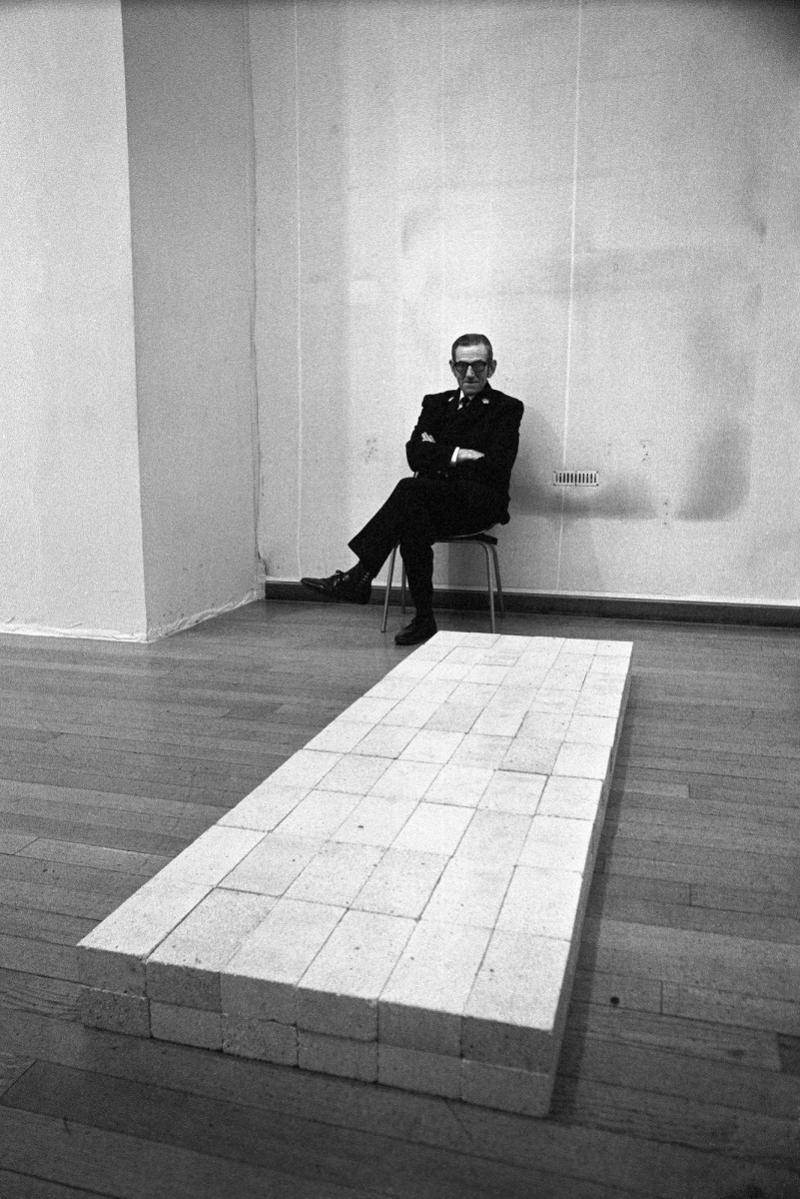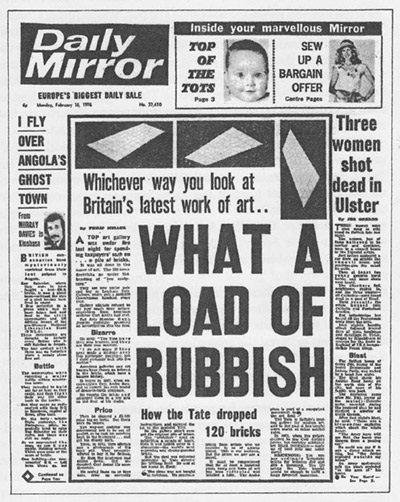Bricks!, BBC Four | reviews, news & interviews
Bricks!, BBC Four
Bricks!, BBC Four
Forty years on: the accidental furore around Carl Andre's work remembered

The wilder shores of contemporary visual art are now ephemeral or time-based: performance, installation, general carry-on and hubbub. But once upon a time – say, the 1960s – it was the nature of objects, pared down to essentials, and often made from real materials sourced from the streets, builders’ yards and shops, that startled: the idea made manifest without old-fashioned notions of the hand-made, craft or manual skill.
The making could even be outsourced, and one critic called minimalism “ABC art”, reduced almost literally to building-block art: form or colour representing nothing but itself with nary an emotional gesture in sight. Dan Flavin used neon tubes, Donald Judd made metal boxes, Robert Ryman painted all-white canvases, Ad Reinhardt took to black. It was an ism that nakedly exposed the fact that art, however constructed, is first of all an idea.
Shock-horror outrage as the rest of the media gleefully followedNowhere was the controversy and perplexity that ensued more manifest than in the accidental furore and scandal attached to the Tate’s purchase of Equivalent VIII, 120 firebricks arranged in a two-brick-high rectangle, six bricks across and ten long by the American poet, conceptualist and sometime freight brakeman for the Pennsylvania Railroad, Carl Andre. The artist, no stranger to controversy both artistic and personal – he was accused of murdering his wife in the 1980s and acquitted after a three-year legal process – is now a revered octogenarian, represented in the most prestigious world collections. What cost the Tate under £3,000 in 1972 (equivalent to about £30,000 today) would be worth somewhere in seven figures now.
It was all a media accident. Equivalent VIII had been shown at the Tate Gallery several times, exciting neither interest nor comment. Cue The Sunday Times, in fact its Business section, dispatching early in 1976 a lively journalist Colin Simpson (who, we were told, left post-Murdoch in 1984 to run a gardening business) to sniff out controversy at the national gallery of modern art: the Tate report containing an illustrated annotated list of acquisitions for 1972-1974 provided rich pickings. Public money – thousands of pounds – spent on 120 firebricks! Bricks! Shock-horror outrage as the rest of the media gleefully followed through the succinct exposé (the Daily Mirror cover, pictured below). And a good time was had by all – or was it?
 Clare Beaven’s rather hilarious visual essay jumped all over the place, talking to the survivors of the contretemps – journalists, curators, lecturers – and critics; it was laced with contemporary photographs, interspersed by pop groups singing relevant lyrics, and endless newspaper articles about how the Tate had dropped a brick. In between we had vox pop – two middle-aged ladies saying they did not understand the bricks, but they did appreciate them – and continuing amiable fury from retired chef Peter Stowell-Phillips who had festooned them with blue food dye 40 years ago, and was banned from the Tate for life. We also had actors in unconvincing creaky scenarios reconstructing the events of long ago, pretending to be, among others, the then director of the Tate, Norman Reid.
Clare Beaven’s rather hilarious visual essay jumped all over the place, talking to the survivors of the contretemps – journalists, curators, lecturers – and critics; it was laced with contemporary photographs, interspersed by pop groups singing relevant lyrics, and endless newspaper articles about how the Tate had dropped a brick. In between we had vox pop – two middle-aged ladies saying they did not understand the bricks, but they did appreciate them – and continuing amiable fury from retired chef Peter Stowell-Phillips who had festooned them with blue food dye 40 years ago, and was banned from the Tate for life. We also had actors in unconvincing creaky scenarios reconstructing the events of long ago, pretending to be, among others, the then director of the Tate, Norman Reid.
It was a huge fuss, questions in Parliament and all: at a time of financial crisis the waste of public money by an out-of-touch élite purchasing an incomprehensible “work of art” for the nation seemed to fuel the fury. It remains implicitly astonishing that out of that national anger and noisy debate – the Tate besieged – would eventually emerge Tate Modern, the most visited contemporary art museum in the world.
As usual it was left to a couple of artists (and, surprisingly, the eloquent Brian Sewell) to act as the voices of common sense. Cornelia Parker and Damien Hirst eulogised minimalism with clarity, Hirst – he of the pickled shark, sheep and cows – saying how he wished to inject it with emotion, Parker cogently describing her own art’s debt to the movement. Brian Sewell, notorious for loathing so much about the contemporary, said Tate should have bought all eight of Andre’s varied Equivalents, and then everyone would have understood his themes and variations. Andre himself, shown in various guises, from full-bearded to minimally hirsute, had the last word: his art was made to question, and he did not have any answers.
rating
Explore topics
Share this article
Add comment
The future of Arts Journalism
You can stop theartsdesk.com closing!
We urgently need financing to survive. Our fundraising drive has thus far raised £49,000 but we need to reach £100,000 or we will be forced to close. Please contribute here: https://gofund.me/c3f6033d
And if you can forward this information to anyone who might assist, we’d be grateful.

Subscribe to theartsdesk.com
Thank you for continuing to read our work on theartsdesk.com. For unlimited access to every article in its entirety, including our archive of more than 15,000 pieces, we're asking for £5 per month or £40 per year. We feel it's a very good deal, and hope you do too.
To take a subscription now simply click here.
And if you're looking for that extra gift for a friend or family member, why not treat them to a theartsdesk.com gift subscription?

Comments
Amazing episode and brought
Amazing episode and brought back memories of visiting them in the 70s on a day release from Barts Hospital in my thirties, weighing six stone, with Leukaemia. They made such an impression that now 73 I have built a gallery on my farm in rural herefordshire and am proud to have Carl Andre's Isoclast 07 Graphite Bricks on display
http://uk.prweb.com/releases/2016/9/prweb13687647.htm